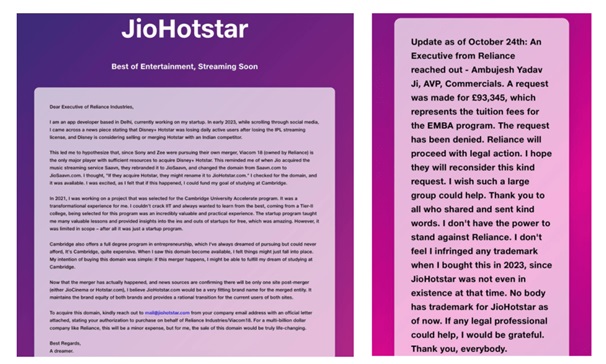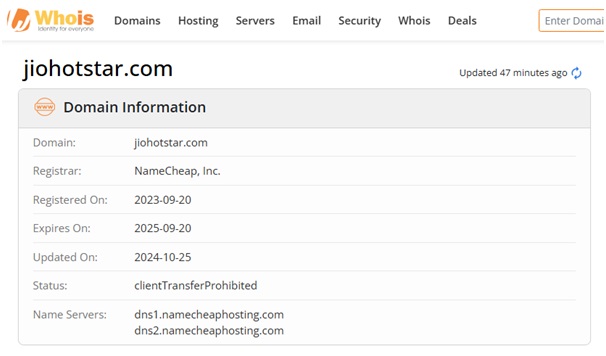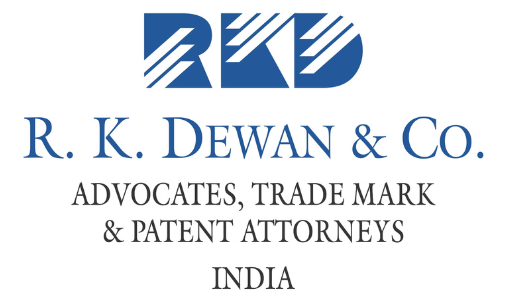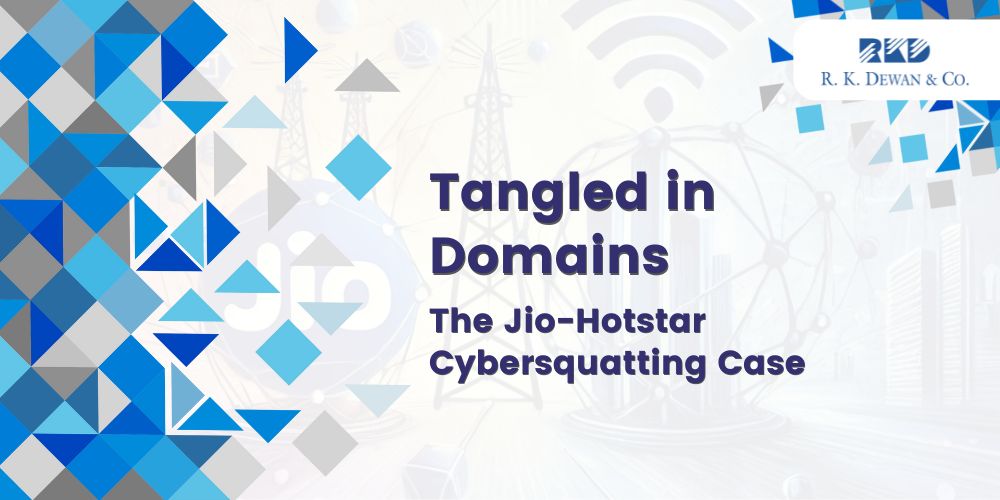In September 2023, an App developer devised a sophisticated plan of cybersquatting by purchasing the domain “jiohotstar.com”. Anticipating a potential merger between Hotstar (owned by Disney+) and Jio similar to Jio’s earlier acquisition of JioSaavn, the developer sought to capitalize on this opportunity. Their strategy was to sell the domain for a significant profit, with the ambitious aim of funding his education at Cambridge University.

*We do not claim any copyright in the above image. The same has been reproduced for academic and representational purposes only.
This deliberate act highlights the persistent issue of cybersquatting in online branding and trademark protection.In this article we will analyse the incident, explain the concept of cybersquatting, and explore the role of the Uniform Domain-Name Dispute-Resolution Policy (UDRP) in addressing such issues.
What is Cybersquatting?
The United States Government in the late 1990s ushered in the commercialization of the Internet and spawned the expansion of the domain name systems. It did not take long for the United States to realize the disadvantage of internet commercialization i.e., “cybersquatting.”
Cybersquatting is the occupation, in bad faith, of a domain name by someone who has no legitimate right, or interest, to the name. It involves the malafide registration of domain names that infringe upon existing trademarks. These domains are often purchased with the intent to sell them back to trademark owners at inflated prices.

*We do not claim any copyright in the above image. The same has been reproduced for academic and representational purposes only.
Acknowledging the threat of cybersquatting to consumer trust the United States Government asked the World Intellectual Property Organization (WIPO) to conduct a study on domain name and trademark issues. WIPO’s recommendations culminated in the Uniform Domain Name Dispute Resolution Policy(UDRP), which has proven to be a highly successful and effective online tool for protecting brand owners’ rights and for building consumer confidence in global e-commerce.
The UDRP’s Three-Pronged Test
For a trademark owner to successfully reclaim a domain through the UDRP, three conditions must be met:
- Confusing Similarity: The disputed domain must be identical or confusingly similar to a registered trademark. In the case of “jiohotstar.com,” trademarks for both “Jio” (held by Reliance Industries) and “Hotstar” (held by Disney/Star Television Productions) exist. The combination of these two brands in the domain name creates a high likelihood of confusion.
- Lack of Legitimate Interest: The individual or entity registering the domain must not have a legitimate right or interest in the name. In this case, the developer who purchased “jiohotstar.com” has no affiliation with either Jio or Hotstar, suggesting a lack of legitimate interest.
- Bad Faith Registration and Use: The domain must have been registered and used with the intent to profit from the brand’s established reputation. The intent to resell “jiohotstar.com” for financial gain clearly indicates bad faith.
A well-known case that demonstrates how these principles work in practice is Decathlon v. Nadia Michalski (Case No. D2014-1996).
Case Study: Decathlon v. Nadia Michalski
In this UDRP case, French sporting goods retailer Decathlon filed a complaint against the registrant of the domain name “decathlon-nike.com,” arguing that it infringed on their trademark.
- Facts: Decathlon owns the registered trademark “Decathlon,” a globally recognized brand. The domain in question incorporated both “Decathlon” and the trademark “Nike,” creating a likelihood of consumer confusion.
- Claims: Decathlon argued that the domain was confusingly similar to their trademark, the registrant had no legitimate interest in using it, and it was registered in bad faith. The inclusion of two well-known trademarks raised concerns about potential use for counterfeit sales and/or misleading customers.
- Panel Decision: The UDRP panel ruled in Decathlon’s favour, finding that the domain created confusion, lacked legitimate use, and was likely registered in bad faith. As a result, the panel ordered the transfer of the domain to Decathlon. However, the decision explicitly stated that the transfer is without prejudice to any rights that might be asserted by Nike International Ltd, with regard to the domain name.
This case sets a precedent for how UDRP can handle disputes involving domain names that combine not just one but multiple trademarks.

*We do not claim any copyright in the above image. The same has been reproduced for academic and representational purposes only.
In the case of “jiohotstar.com,” the developer’s actions bear strong similarities to the Respondent i.e., Nadia Michalskiin the Decathlon case. The combination of two established trademarks Jio and Hotstar along with the intention to profit from a potential business merger, strongly suggests bad faith. Additionally, the three-pronged test laid down by the URDP is also satisfied wherein:
- The combination of “jio” and “hotstar”creates a domain that is confusingly similar to these established brands, likely misleading users into believing it is affiliated with or endorsed by either company;
- The app developer has no legitimate interest in using the domain name. They are not connected to either Jio or Hotstar, and the registration of “jiohotstar.com” serves no genuine purpose other than to profit from a speculative business merger; and
- The developer’s intention to sell the domain for a large sum, exploiting the potential Jio-Hotstar merger, clearly indicates bad faith. The act of registering a domain that combines the trademarks of two well-known companies with the sole intent of profiting from their potential business moves exemplifies bad-faith registration.
Hence, based on the above demonstration of cybersquatting it is highly likely that Reliance Industries and Disney will file a UDRP complaint to reclaim the domain. Given the precedent set by previous UDRP rulings, the domain would likely be transferred to its rightful trademark owners.
Lessons for Brand Owners: A Cautionary Tale
For trademark holders, the JioHotstar case serves as a reminder to remain vigilant. Cybersquatting poses a significant risk to brand reputation and consumer trust. Hence, to strengthen the brand these additional steps should to be undertaken by brand owners:
- Proactive Domain Registration: Register domain names at the initial stage in all locations where you do business. Additionally, consider registering variations of your brand name, by adding articles (e.g., “the”). This demonstrates vigilance and helps in a potential case of deceptive similarity.
- Prioritize Popular Domain Names: For particularly popular domain names, secure registrations in relevant country-code i.e., Top-Level Domains (TLDs) based on the business location (e.g., “.cn” for China, “.ai” for Anguilla, “.tv” for Tuvalu).
- Continuous Monitoring: The Information Technology team of an entity should continuously monitor for similar domain names being registered. Keep a look-out for registrations that combine your trademark with other well-known brands, as seen in the “jiohotstar.com” case.
Additionally, the entities that assist in registering a domain name must undertake the responsibility of conducting due-diligence on their part by requesting applicants to provide for copies of their trademark application or registration certificate before registering a domain name.
In a digital age where domain names are critical brand identifiers, the threat of cybersquatting is omnipresent especially in high-profile industries where brand names are immensely valuable. Entities must be vigilant to protect their Intellectual Property in the digital space, as allowing such infringements can lead to reputational damage, loss of customer confidence, and even financial harm. Fortunately, the (UDRP) offers a relatively swift and cost-effective remedy for businesses that find themselves targeted by Cybersquatters. The stages of a UDRP proceeding usually involve:
Stage 1: Filing of a complaint;
Stage 2: Commencement of Administrative Proceeding;
Stage 3: Filing of Response;
Stage 4: Appointment of Panel:
Stage 5: Panel Decision:
Stage 6: Notification of Decision; and
Stage 7: Implementation of Decision
By providing a structured and streamlined process, UDRP enables trademark holders to reclaim domains registered in bad faith without resorting to lengthy legal battles, thereby ensuring that they can swiftly protect their online presence and brand integrity.


